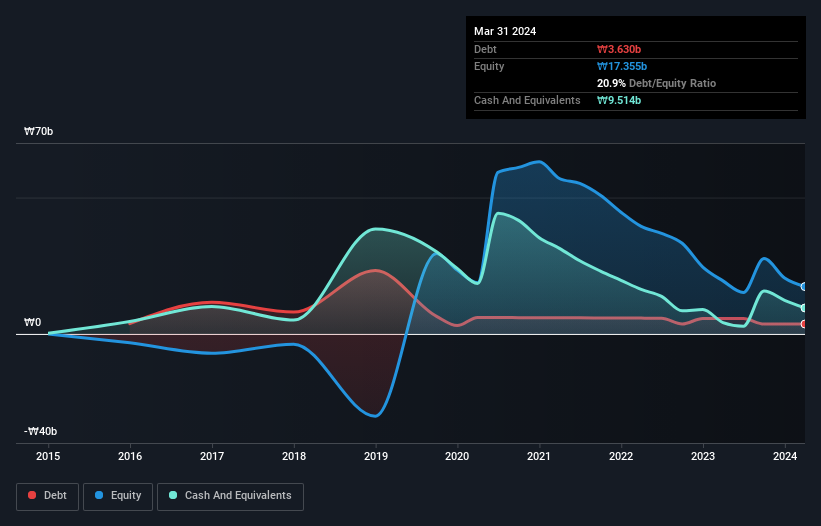Some say volatility, rather than debt, is the best way to think about risk as an investor, but Warren Buffett famously said that 'Volatility is far from synonymous with risk.' When we think about how risky a company is, we always like to look at its use of debt, since debt overload can lead to ruin. As with many other companies SCM Lifescience Co., Ltd. (KOSDAQ:298060) makes use of debt. But the more important question is: how much risk is that debt creating?
What Risk Does Debt Bring?
Debt and other liabilities become risky for a business when it cannot easily fulfill those obligations, either with free cash flow or by raising capital at an attractive price. Ultimately, if the company can't fulfill its legal obligations to repay debt, shareholders could walk away with nothing. While that is not too common, we often do see indebted companies permanently diluting shareholders because lenders force them to raise capital at a distressed price. Of course, plenty of companies use debt to fund growth, without any negative consequences. The first thing to do when considering how much debt a business uses is to look at its cash and debt together.
Check out our latest analysis for SCM Lifescience
How Much Debt Does SCM Lifescience Carry?
As you can see below, SCM Lifescience had ₩3.63b of debt at March 2024, down from ₩5.63b a year prior. But on the other hand it also has ₩9.51b in cash, leading to a ₩5.88b net cash position.

How Healthy Is SCM Lifescience's Balance Sheet?
We can see from the most recent balance sheet that SCM Lifescience had liabilities of ₩1.17b falling due within a year, and liabilities of ₩3.79b due beyond that. On the other hand, it had cash of ₩9.51b and ₩242.0m worth of receivables due within a year. So it actually has ₩4.79b more liquid assets than total liabilities.
This surplus suggests that SCM Lifescience has a conservative balance sheet, and could probably eliminate its debt without much difficulty. Simply put, the fact that SCM Lifescience has more cash than debt is arguably a good indication that it can manage its debt safely. The balance sheet is clearly the area to focus on when you are analysing debt. But you can't view debt in total isolation; since SCM Lifescience will need earnings to service that debt. So when considering debt, it's definitely worth looking at the earnings trend. Click here for an interactive snapshot.
Over 12 months, SCM Lifescience reported revenue of ₩826m, which is a gain of 117%, although it did not report any earnings before interest and tax. So its pretty obvious shareholders are hoping for more growth!
So How Risky Is SCM Lifescience?
By their very nature companies that are losing money are more risky than those with a long history of profitability. And in the last year SCM Lifescience had an earnings before interest and tax (EBIT) loss, truth be told. Indeed, in that time it burnt through ₩12b of cash and made a loss of ₩22b. With only ₩5.88b on the balance sheet, it would appear that its going to need to raise capital again soon. Importantly, SCM Lifescience's revenue growth is hot to trot. While unprofitable companies can be risky, they can also grow hard and fast in those pre-profit years. The balance sheet is clearly the area to focus on when you are analysing debt. But ultimately, every company can contain risks that exist outside of the balance sheet. To that end, you should learn about the 5 warning signs we've spotted with SCM Lifescience (including 2 which are concerning) .
At the end of the day, it's often better to focus on companies that are free from net debt. You can access our special list of such companies (all with a track record of profit growth). It's free.
New: Manage All Your Stock Portfolios in One Place
We've created the ultimate portfolio companion for stock investors, and it's free.
• Connect an unlimited number of Portfolios and see your total in one currency
• Be alerted to new Warning Signs or Risks via email or mobile
• Track the Fair Value of your stocks
Have feedback on this article? Concerned about the content? Get in touch with us directly. Alternatively, email editorial-team (at) simplywallst.com.
This article by Simply Wall St is general in nature. We provide commentary based on historical data and analyst forecasts only using an unbiased methodology and our articles are not intended to be financial advice. It does not constitute a recommendation to buy or sell any stock, and does not take account of your objectives, or your financial situation. We aim to bring you long-term focused analysis driven by fundamental data. Note that our analysis may not factor in the latest price-sensitive company announcements or qualitative material. Simply Wall St has no position in any stocks mentioned.
Have feedback on this article? Concerned about the content? Get in touch with us directly. Alternatively, email editorial-team@simplywallst.com
About KOSDAQ:A298060
SCM Lifescience
Operates in the stem cell therapy, CMO, contract research and consulting, and cosmetic businesses.
Flawless balance sheet with slight risk.
Similar Companies
Market Insights
Community Narratives



